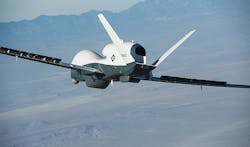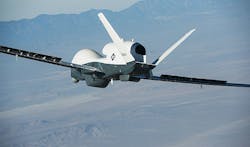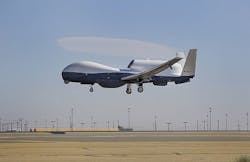Triton UAV: built by industry leaders, powered by Rolls-Royce engine
PALMDALE, Calif., 22 May 2013. A single Rolls-Royce AE 3007 engine powers the MQ-4C Triton high-altitude, unmanned aircraft built by a Northrop Grumman-lead team.
Northrop Grumman is the prime contractor to the Navy’s MQ-4C Triton Broad Area Maritime Surveillance program. In 2008, Northrop Grumman won a systems development and demonstration contract to build two aircraft and test them in preparation for operational missions. The Navy’s program of record calls for 68 Tritons to be built.
In addition to Rolls-Royce, Northrop Grumman’s Triton industry team includes Aurora Flight Sciences, BAE Systems, Curtis-Wright Corp., L3 Communications, Raytheon, Sierra Nevada Corporation and Vought Aircraft Industries.
The aircraft is specially designed to fly surveillance missions up to 24 hours at altitudes over 10 miles—enabling coverage of up to 2,000 nautical miles.
Triton carries a variety of intelligence, surveillance, and reconnaissance (ISR) sensor payloads that enable military commanders to gather high-resolution imagery, use radar to detect targets, and provide airborne communications and information-sharing capabilities to military units across long distances. The advanced suite of sensors can detect and automatically classify different types of ships.
The AE 3007 provides the fuel efficiency required as well as the electrical power necessary for the tasks. The Rolls-Royce AE 3007 engine also powers the Northrop Grumman Global Hawk, another high-altitude, unmanned aircraft, as well as various corporate and regional jets. The AE 3007’s reliability and efficiency have been demonstrated in military and commercial service, with the engine line recently topping 50 million flight hours.
“Triton is the most advanced ISR unmanned aircraft system ever designed for use across vast ocean areas and coastal regions. Through a cooperative effort with the Navy and our industry partners we successfully demonstrated the flight control systems that allow Triton to operate autonomously. We couldn’t be prouder of the entire team for this achievement,” says Mike Mackey, Northrop Grumman’s deputy program director for Triton.
At 130.9 feet, Triton has a wingspan larger than many commercial airliners. Combined with the efficient Rolls-Royce engine and other aerodynamic design features, Triton can fly 11,500 miles without refueling.
The first flight was conducted 22 May 2013 at Northrop Grumman’s manufacturing facility in Palmdale, Calif.
Follow Avionics Intelligence news updates on Twitter (@Avionics_Intel), LinkedIn, and Google+.
Related stories
Northrop Grumman-built Navy Triton unmanned aircraft achieves historic first flight, begins testing
Military surveillance strategy for Asia-Pacific region includes Northrop Grumman Triton UAS and Boeing P-8A Poseidon
Triton UAV: built by industry leaders, powered by Rolls-Royce engine


